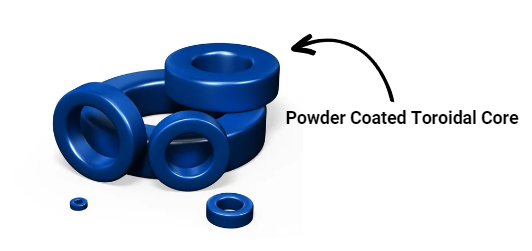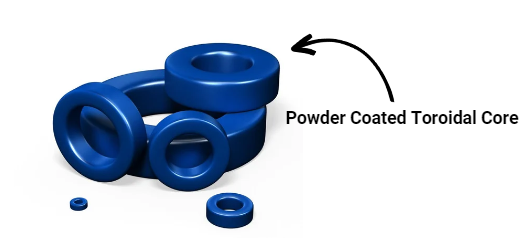Inductors
An inductor is an electronic component that stores energy temporarily in its magnetic field. It's composed of two terminals and a conductor, which is usually copper wire. This can be wrapped around air or a core material, for example, iron.

When the wire is coiled around a material instead of air, this can make the magnetic field stronger. If the current passing through the inductor changes, the stored energy is quickly released. This happens due to the magnetic field of the inductor collapsing due to the current change.
One of the most important qualities that inductors have is their ability to protect circuits from sudden changes in current. They do this by resisting changes in the flow of electricity, and the circuit is protected from shortages due to current spikes and fluctuations. This ability of an inductor is measured through the Inductance. More specifically, the inductance is the measure of the strength of the magnetic field for a measure of current passing through. To measure inductance, the Hennry (H) is used. One Henry is equivalent to one volt-second per ampere. Inductance can be affected by various factors, such as:
- Material of the coil (copper,
- Material of the core (air, iron, ferrite, etc.)
- Total area of the coil
- Number of times the coil is wound
- Material permeability
In practical applications, inductance is a crucial parameter as it affects how an inductor behaves in a circuit. It influences the inductor's ability to resist changes in current and voltage and plays a significant role in determining the behavior of electrical systems involving inductors, such as filters, transformers, and motors.
The following is a table of inductors that use specialty chemicals, adhesives, and plastics:
| Type of Inductor | Core Material | Advantages | Applications |
| Air Core Inductor | Non-conductive medium, like air or plastic | No iron losses due to increased frequency | High frequency |
| Iron Core Inductor | Iron Core | High inductance | Power |
| Ferrite Core Inductor | Ferrite Core | Good magnetic and high-frequency properties | Radio Frequency Circuits |
| Variable Inductor | Ferrite core in a threaded structure | Allows inductance to be adjusted based on the core position | Power, radio frequency circuits, research and development |
| Toroidal Inductor | Ferrite, Iron, or metal core | Closed loop shape allows wide frequency range, high inductance, and low EMI (electromagnetic interference) | Power, radio, audio, and medical equipment (low EMI required) |
Epoxy Coating Powders for Inductors
GCP18-05: Halogen-Free Epoxy Coating Powder for Passive Electronic Components
LINQSOL™ GCP1805 is an insulating epoxy coating powder for capacitors, varistors, and other passive components. It was designed specifically as a halogen-free version of DK18-05 with similar technical specifications, just without containing any of the halogens. It can be applied through a fluidized bed with temperatures as low as 105°C. Its excellent curing conditions make the epoxy coating powder also very suitable for tantalum capacitors and other temperature-sensitive devices.
LINQSOL™ GCP1805 epoxy coating powders are laser markable and are rated with a UL 94 V-0 flammability and RTI rating of 130°C.

What is a Toroidal Inductor?
A toroidal core functions as an inductor, comprising two key components: a magnetic core and a coiled wire. When the wire is meticulously wound around the core, it generates a magnetic field that stores electric charge. In electronic circuits, the primary role of an inductor is to resist changes in the flow of current. Toroids come in various sizes and materials for their cores, and these variations influence their behavior across different frequencies. The way the coils are wound also plays a crucial role in determining the inductor's ability to store a magnetic charge.
What Differentiates Toroidal Inductors from Other Inductors?
What separates toroidal inductors from other inductors is the shape. Compared to other inductors like ferrite or air core inductors, a toroidal inductor is shaped in a circle, like a doughnut. This closed loop shape allows for a wide frequency range. Also, it helps to minimize Electromagnetic Interference, due to the shape being able to concentrate the magnetic flux within the core. The core material is most commonly ferrite, iron, or metal.
.png)
Benefits of a Toroidal Inductor
| Quality | Advantage |
| High Inductance | The shape of the toroidal inductor results in a higher inductance value. |
| Wide Frequency Range | A wide frequency range is important for proper signal transmission and reception, which can be useful in radio and communication systems. |
| Low EMI | A low electromagnetic interference is beneficial due to its ability to maintain inductance ability and efficiency at low and high frequencies. |
| Compact Size | The compact size allows the inductor to be used in applications where there a size constraints. |
Toroids can be coated or uncoated, however coating a toroid with epoxy coating powder like the Linqsol GCP-1805 Halogen-Free Epoxy Coating Powder has many benefits, including:
- Enhanced Insulation: Coating the toroid creates a superior insulation barrier between the magnetic core and the wire windings. This protective layer enhances the core's performance by reducing the occurrence of short circuits and electrical failures.
- Corrosion Protection: As the core is typically made of metal, it is susceptible to corrosion. Epoxy coating powder acts as a protective shield, preventing moisture contact with the core, thus significantly lowering the risk of corrosion and potential failure.
- Increased Durability: Epoxy coating powder provides essential protection to the magnetic core, creating a barrier between the copper wires and the core itself. This safeguard ensures the core's longevity while maintaining its intended functionality as a toroid.
- Time Efficiency: In cases where toroids remain uncoated, additional materials such as tape are often employed to establish the necessary insulation barrier. Coating with epoxy powder eliminates this step, streamlining the manufacturing process and reducing production time.
- Aesthetics: Occasionally, toroids may be placed in visible locations where they need to meet specific design standards. Epoxy coating powder offers the advantage of customization regarding color and provides a sleek, glossy, and uniform finish, enhancing their appearance.

Epoxy Coating Powder for Toroidal Inductors
Some key material properties of the Linqsol GCP-1805 - Halogen Free Epoxy Coating Powder:
- Low-Temperature, Ultra-Fast Cure Speed: This coating cures rapidly at low temperatures, saving time and energy in the manufacturing process.
- Low Shrinkage: The coating exhibits minimal shrinkage during curing, reducing stress on the toroid's core.
- Low Moisture Absorption: Its low moisture absorption properties further decrease stress on the core and enhance overall performance.
- Halogen-Free: The coating is free of halogen elements, making it environmentally friendly and safe for various applications.

